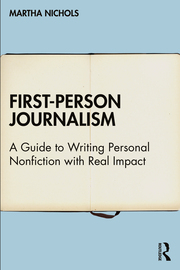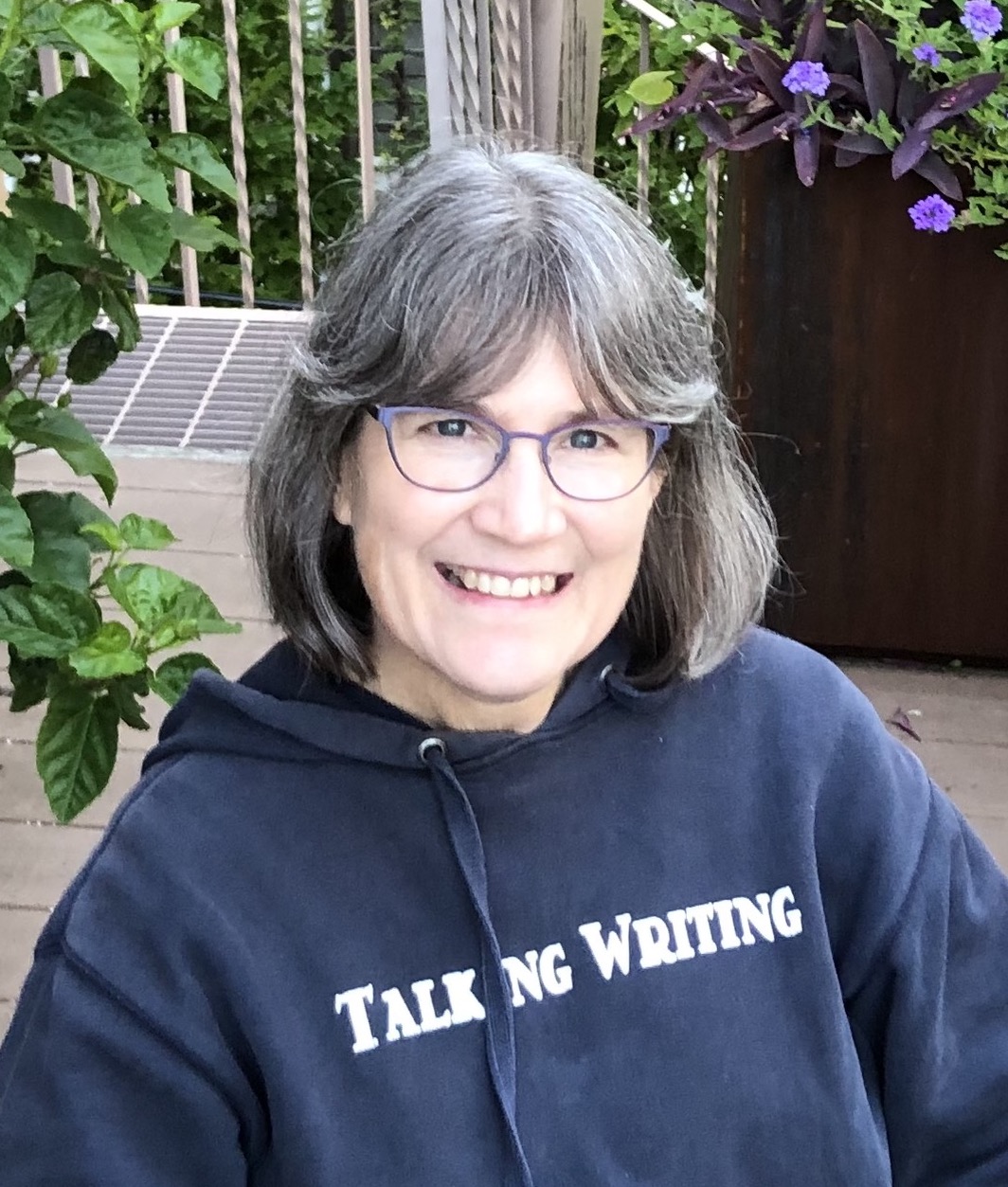Memorial by Martha Nichols
Honoring a Master First-Person Journalist

We tell ourselves stories in order to live. The princess has caged a butterfly in her fingers. The man walks into a classroom with a gun. The woman feels naked but isn’t or is virtually naked in a virtual background from a photograph she never took. We never imagine what we don’t want to know.
The boldfaced line is Joan Didion’s from “The White Album,” but the rest is me—or me taking on her voice, that familiar phrasing, that tendency to stand back and document. Like her, I grew up in California. I’m younger (she was my parents’ age) but also skeptical, contrarian, questing, anxious, hyper-sensitive. Old shoes aren’t always comfortable, but they take up space in the closet for a reason.
And once again, I’m channeling Joan Didion.
I miss her already, that’s the thing. I’ve been expecting to miss her for a long time. This past year, I kept wondering where she was and how she was doing while I finished writing First-Person Journalism, a book that owes much to her and was recently published by Routledge. “As I came of age in the 1970s,” I say in the introduction, “my love of first-person nonfiction really blossomed when I discovered Joan Didion.”
After her death on December 23, tributes to Didion (1934–2021) are well under way in the media, and there’s nothing I can add regarding the narrative of her life. The New York Times obituary by William Grimes, “Joan Didion, ‘New Journalist’ Who Explored Culture and Chaos, Dies at 87,” is a good place to start: “Ms. Didion’s reporting, reflected Norman Mailer’s prescription for ‘enormously personalized journalism in which the character of the narrator was one of the elements in the way the reader would finally assess the experience.’”
“Enormously personalized” is overstating it for me and probably for her. But the bombast of Norman Mailer aside, this kind of personalizing—what I’d call self-reporting—was taboo-breaking for journalism at the time.
In "The Radical Transparency of Joan Didion," another New York Times piece, Frank Bruni emphasizes her ability to build trust with readers through personal exposure, a quality I also underscore in First-Person Journalism. Meanwhile, Zadie Smith's sharp-eyed assessment in the New Yorker, "Joan Didion and the Opposite of Magical Thinking," pins down why her style meant so much to women of our generation. Smith writes:
It was the authority. The authority of tone. There is much in Didion one might disagree with personally, politically, aesthetically.... But I remain grateful for the day I picked up Slouching Towards Bethlehem and realized that a woman could speak without hedging her bets, without hemming and hawing, without making nice....

I think Didion was always aware that others would be reading her words. They weren’t simply offered as an emotional dump on the page. For me, she was a cool witness of a soul in distress. She used the grist of her own confusion to forge a link between her personal experience and cultural upheavals, ultimately saying, Look at us, not knowing what to do except to describe what we see.
This fall, I happened to read “The White Album” yet again (it's from her 1979 essay collection of the same name) while teaching my Feature Writing course. Our class discussions about her iconic essay have been with me ever since, but now I find the famous opening tolling through my mind: “We tell ourselves stories in order to live…. We look for the sermon in the suicide, for the social or moral lesson in the murder of five. We interpret what we see, select the most workable of the multiple choices.”
The princess squeezes too hard. The butterfly is not released. We tell ourselves we’re living through “interesting” times, but I am the naked woman, the virtual woman, the princess or the trapped butterfly. The woman has been vaccinated with worries, and we keep saying it’s not enough, but my “I” is trapped behind that “we.” We imagine bodies piling up in hospitals or trailers or graves, then unimagine what we know to make them disappear. We imagine Covid as the demon in ourselves or the fate we’re supposed to deserve.
With Didion’s death, the connection between current and past disruptions seems heightened, almost as if there’s a cosmic hand steering the way I contemplate the unraveling of what used to be normal. Except the writer of “The White Album” would expose the romantic impulse behind such a story. In that long essay, Didion collaged together “flash cuts”—living in LA in the 1960s, reporting on the Doors or a sit-in at San Francisco State, reacting to the Manson murders—undermining traditional narrative. She offered plenty of stories, then told readers none of them made sense.
But Didion’s best essays are packed with small moments among the public events. Her voice is indelible because of the details, and if meaning is to be found, it’s in the minutia. In “On Keeping a Notebook” from her 1968 collection Slouching Towards Bethlehem, sauerkraut evokes lost time more slyly than a madeleine. She leaves the taste of bourbon on the tongue.
At the start of that essay, Didion describes staring at a note she jotted down that “presumably has some meaning for me.” She then asks:
Why did I write it down? In order to remember, of course, but exactly what was it I wanted to remember? How much of it actually happened? Did any of it? Why do I keep a notebook at all? It is easy to deceive oneself on all those scores.
“On Keeping a Notebook” contends with how ephemeral lived experience is and why evoking details through words is not just a writer’s trick. Verbal snapshots are subjective and particular, but the grainy incompleteness is what makes them feel honest. "It all comes back," she replied to her own questions, and her response makes me want to keep writing forever:
I think we are well advised to keep on nodding terms with the people we used to be, whether we find them attractive company or not. Otherwise they turn up unannounced and surprise us, come hammering on the mind’s door at 4 a.m. of a bad night and demand to know who deserted them, who betrayed them, who is going to make amends. We forget all too soon the things we thought we could never forget.
It all comes back. Those words from 50-plus years ago still tingle when I read them. They move and brace me in a world that seems increasingly chaotic. More than ever, I want to tell readers I don’t understand. Yet I’ll continue looking for connections, the small moments that come back through the act of writing them down. Writers can be both truthful and uncertain, yet I believe it’s possible to tell a dissonant story.
The woman claims no false knowledge. The woman is not the princess or the butterfly but maybe she always has been. We decide how virtual the background is. The woman steps out of the screen into life, shivers, sees herself, takes a huge bite.
Maybe storytelling is only for the living, for those of us who need to craft something from nothing to face the void. I’d like to tell this great writer her words will always come back, although I don’t know if that's true. And yet, I thank Joan Didion for being my guiding light. It helps to document what I see and feel in this world, even if I’ll never be satisfied.

This memorial essay was originally published in Martha's newsletter on December 24, 2021, in a slightly different form. For more reflections about first-person journalism, subscribe to her newsletter by clicking on the link. It's free!
Publishing Information
- "The White Album" in The White Album by Joan Didion (Farrar, Straus and Giroux, 1979).
- "How I Became a First-Person Journalist" (Chapter 1) in First-Person Journalism: A Guide to Writing Personal Nonfiction with Real Impact by Martha Nichols (Routledge, 2022).
- “Joan Didion, ‘New Journalist’ Who Explored Culture and Chaos, Dies at 87” by William Grimes, New York Times, December 23, 2021.
- "The Radical Transparency of Joan Didion" by Frank Bruni, New York Times, December 24, 2021.
- "Joan Didion and the Opposite of Magical Thinking" by Zadie Smith, New Yorker, December 24, 2021.
- "On Keeping a Notebook" in Slouching Towards Bethlehem by Joan Didion (Farrar, Straus and Giroux, 1968).
Art Information
- "Joan of Arc Monument" © Paul VanDerWerf; Creative Commons license.
- "Didion at the 2008 Brooklyn Book Festival" © David Shankbone; Creative Commons license.
 Martha Nichols co-founded Talking Writing and is a faculty instructor in the journalism program at the Harvard University Extension School. Much of her teaching craft appears in her recent book First-Person Journalism: A Guide to Writing Personal Nonfiction with Real Impact (Routledge, 2022).
Martha Nichols co-founded Talking Writing and is a faculty instructor in the journalism program at the Harvard University Extension School. Much of her teaching craft appears in her recent book First-Person Journalism: A Guide to Writing Personal Nonfiction with Real Impact (Routledge, 2022).
For more information, subscribe to her newsletter and website: Martha Nichols Writer.
